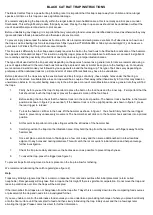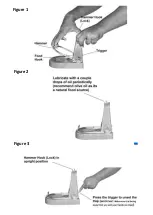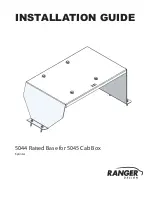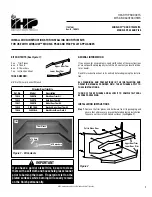
BLACK CAT RAT TRAP INSTRUCTIONS
The Black Cat Rat Trap is a powerful trap for killing rats. It is important that this trap is kept away from children and non-target
species at all time as this trap can cause significant damage.
We recommend placing the trap directly within the target rodent’s main habitation area, this is normally an attic space or under
floorboards. This will significantly reduce third party access. Placing the trap in open areas should not be undertaken without the
use of an additional protection device to limit access.
Before undertaking any trapping, it is important that any competing food sources are identified and removed as otherwise they may
ignore alternative foods placed within an otherwise safe environment.
To prevent injury please read the below instructions. We also recommend viewing some excellent YouTube videos on how to set
the trap as well as baiting tips for rats and squirrels. https://youtu.be/YT4O2A9e08Q or https://youtu.be/UkypVlF_Jdc however a
quick search of ‘Black Cat Trap’ will show several results.
This trap works differently to other traps and actually requires the bait on the food hook to be lifted before activation of the hammer,
the opposite of standard rat traps. This results in a slightly longer process from acceptance to kill however can result in significant
more catches and the possibility of multi-kills at one time when using in large infestation areas.
The type of bait used within the trap will vary depending on the species however as a general rule for rats we recommend using a
piece of apple attached to the main food hook followed by a spread of oats or similar loose grain to the feeding cup. For squirrels
we recommend a solid monkey nut followed by loose peanuts around the feeding cup. The type of bait does vary depending on
preference of that individual rodent so a trial and error of some different baits may have to be undertaken.
Before placement of the traps survey the environment and look for signs of activity, these maybe holes under the flooring or
insulation in the attack. A suitable place to set a trap would be a couple of feet away rather than directly in front that may make an
unwelcome obstacle. For squirrel baiting keep only to the attic space or area of main infestation and as a general rule they will find
the traps.
1.
Firstly, before you set the trap it’s important to place the bait on the food hook and the inner cup. It’s important that the
bait should not touch the trap body or prevent the upwards motion of the food hook.
2.
Before setting the trap check that the hammer lock is in the correct position. The hammer lock should be in the forward
position as shown in figure 2 (see overleaf). If the hammer lock is in the upright position, as shown in figure 3, press
the rear trigger to release.
3.
To lock the hammer, kill bar in the hook, lift the hammer as shown in figure 1. You should firmly hold the rear trigger
tower to prevent any unnecessary movement. The hammer bar will click on to the hammer hook and lock into a primed
position.
4.
At this point its important not to place fingers within the kill radius of the hammer bar.
5.
Carefully position the trap into the infestation area. Only hold the trap from the rear tower, with fingers away from the
hammer bar.
6.
Once set place a small amount of bait approx. a few cm’s away and then some additional bait in a few locations
adjacent to any holes and nesting materials. This will catch the rat or squirrel’s initial attention and help encourage
further investigation.
7.
Check the trap twice daily and remove the bodies as soon as possible to prevent trap shyness.
8.
To unset the trap, press the trigger (see figure 3).
To prevent traps from being moved a hole is present on the trap to allow for tethering
We recommend lubricating the catch regularly (see figure 2)
Help
Traps may initially be ignored as this is a common response from rats and squirrles after initial placement (a term called
neophobia). Rats generally will only take from a trap on the first night if there is siginificant competetion. Do not move the trap and
leave in poisition as over time the traps will be accepted.
If the internal bait from traps are not being taken from the trap after 7 days this is normally down to either competing food sources
or placement of the trap and needs to be investigated further..
If you are unable to control the alternative food sources you can undertake a pre-baiting technique of where you place bait directly
onto the floor surface until the rats start to feed and then slowly introducing the trap, initialy unset and then a few days later
ativating the trigger. Please contact us direct for further information.




















